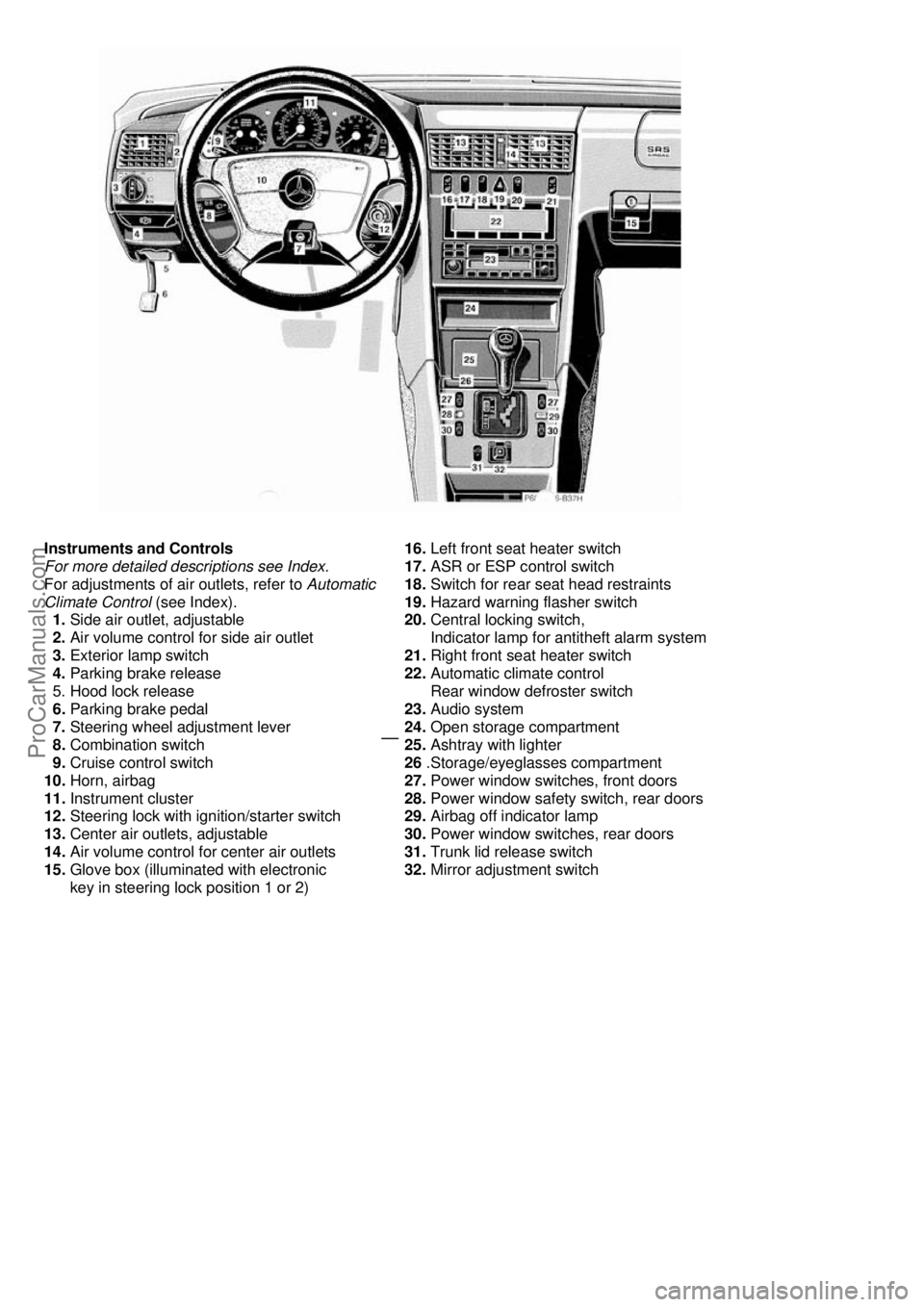parking brake MERCEDES-BENZ C-CLASS 1999 Owners Manual
[x] Cancel search | Manufacturer: MERCEDES-BENZ, Model Year: 1999, Model line: C-CLASS, Model: MERCEDES-BENZ C-CLASS 1999Pages: 122, PDF Size: 1.66 MB
Page 3 of 122

Instruments and Controls
For more detailed descriptions see Index.
For adjustments of air outlets, refer to Automatic
Climate Control (see Index).
1. Side air outlet, adjustable
2. Air volume control for side air outlet
3. Exterior lamp switch
4. Parking brake release
5. Hood lock release
6. Parking brake pedal
7. Steering wheel adjustment lever
8. Combination switch
9. Cruise control switch
10. Horn, airbag
11. Instrument cluster
12. Steering lock with ignition/starter switch
13. Center air outlets, adjustable
14. Air volume control for center air outlets
15. Glove box (illuminated with electronic
key in steering lock position 1 or 2)
16. Left front seat heater switch
17. ASR or ESP control switch
18. Switch for rear seat head restraints
19. Hazard warning flasher switch
20. Central locking switch,
Indicator lamp for antitheft alarm system
21. Right front seat heater switch
22. Automatic climate control
Rear win dow defroster switch
23. Audio system
24. Open storage compartment
25. Ashtray with lighter
26 .Storage/eyeglasses compartment
27. Power window switches, front doors
28. Power window safety switch, rear doors
29. Airbag off indicator lamp
30. Power window switches, rear doors
31. Trunk lid release switch
32. Mirror adjustment switch
ProCarManuals.com
Page 5 of 122

Indicator Lamp Symbols
Function Indicator Lamp
High beam
Battery not being charged properly.
See Index
Warning Lamps
(should go out with the engine running unless)
Exterior lamp failure. See Index
ASR or ESP.
Adjust driving to road condition. See Index
BAS malfunction. See Index
ASR malfunction. See Index
Fluid level for windshield and headlamp
washer system low. See Index
BAS malfunction. See Index
ESP malfunction. See Index
Coolant level low. See Index
ABS malfunction. See Index
Engine oil level low. See Index Fasten seat belts. See Index
Brake pads worn down. See Index SRS malfunction. See Index
Brake fluid low (except Canada).
Parking brake engaged. See Index
Telescoping steering column not locked.
See Index
Brake fluid low (Canada only).
Parking brake engaged.
See Index
Engine malfunction indicator lamp. If the
lamp comes on when the engine is running,
it indicates a malfunction of the fuel
management system or emission control
system, or the fuel cap is not closed tight. In
all cases, we recommend that you have the
malfunction checked as soon as possible.
See Index
Additional Function Indicator Lamps in
the Instrument Cluster
Function Indicator Lamp on
the Center Console
FSS indicator (distance).
See Index
Passenger Airbag automatically switched
off. See Index
FSS indicator (days).
See Index
ProCarManuals.com
Page 7 of 122

Starting and Turning Off the Engine
Before Starting
Ensure that parking brake is engaged and that selector lever is in position "P" or "N".
Turn electronic key in steering lock to position 2. The charge indicator lamp should come on.
Starting (Model C 230)
Do not depress accelerator. Turn electronic key in steering lock clockwise to the stop.
Release electronic key only when the engine is firing regularly.
Starting
(Models C 280, C 43 AMG)
Do not depress accelerator. Briefly turn electronic ke y in steering lock clockwise to the stop and release.
The starter will engage until the engine is running. If engi ne will not run, and the starting procedure stops,
turn electronic key completely to the left and repeat star ting the engine. After several unsuccessful attempts,
have the system checked at the near est authorized Mercedes-Benz dealer.
Important!
Due to the installed starter non- repeat feature, the electronic key must be turned completely to the left before
attempting to start the engine again. The battery charge indicator lamp should go out as soon as the engine
has started. In areas where temperat ures frequently drop below -4°F (-20°C) we recommend that an engine block
heater be installed. Your authorized Mercedes -Benz dealer will advise you on this subject.
Turning Off
Turn the electronic key in the steering lock to position 0 to stop the engine.
The electronic key can only be removed with your foot off the brake pedal and the selector lever in position "P".
ProCarManuals.com
Page 8 of 122

Driving Instructions
Warning !
If you feel a sudden significant vibration or ride disturbance, or you suspect that possible damage
to your vehicle has occurred, you should turn on the hazard flashers, carefully slow down, and drive with
caution to an area which is a safe distance from the roadway.
Inspect the tires and under the vehicle for possible dama ge. If the vehicle or tires appear unsafe, have
it towed to the nearest Mercedes-Benz or tire dealer for repairs.
Power Assistance
Warning !
When the engine is not running, the brake and steering systems are without power assistance.
Under these circumstances, a much greater effo rt is necessary to stop or steer the vehicle.
Brakes
Warning !
After driving in heavy rain for some time without applying the brakes or through water deep enough to
wet brake components, the first braking action may be somewhat reduced and increased pedal
pressure may be necessary. Be sure to maintain a safe distance from vehicles in front.
Resting your foot on the brake pedal will cause excessive and premature wear of the brake pads.
It can also result in the brakes overheating th ereby significantly reducing their effectiveness.
It may not be possible to stop the car in sufficient time to avoid an accident.
The condition of the parking brake system is checked eac h time the car is in the shop for the required service.
If the parking brake is released and the brake warning lamp in the instrument cluster stays on, the brake fluid level in
the reservoir is too low. Brake pad wear or a leak in the system may be the reason for low brake fluid in the reservoir.
Have the brake system inspected at an aut horized Mercedes-Benz dealer immediately.
All checks and maintenance work on the brake system s hould be carried out by an authorized Mercedes-Benz dealer.
Install only brake pads and brake fluid recommended by Mercedes-Benz.
Warning !
If other than recommended brake pads are installed, or other than recommended brake fluid is used, the
braking properties of the vehicle can be degraded to an extent that safe braking is substantially impaired.
This could result in an accident.
Caution !
When driving down long and steep grades, relieve the load on the brakes by shifting into a lower gear. This helps prevent
overheating of the brakes and reduces brak e pad wear. After hard braking, it is advisable to drive on for some time, rather
than immediately parking, so the air stream will cool down the brakes faster.
ProCarManuals.com
Page 10 of 122

Warning !
Ev en
when permitted by law, never operate a vehicle at speeds greater than the maximum speed rating of the
tires. Exceeding the maximum speed for which tires are rated can lead to sudden tire failure causing loss of
vehicle control and resulting in personal injury and possible death.
Parking
Warning !
To reduc e th
e risk of personal injury as a result of vehicle movement, before
turning off the engine
and leaving the vehicle always:
1. Keep right foot on brake pedal
2. Firmly depress parking brake pedal.
3. Move the selector lever to position "P".
4. Slowly release brake pedal.
5. Turn front wheels towards the road curb.
6. Turn the key to steering lock position 0 and remove.
7. Take your key and lock vehicle when leaving
Important !
It is advisable to set the parking b
rake whenever parking or leaving the vehicle. In addition, move selector lever to
position "P". When parking on hills , always set the parking brake.
Winter Driving Instructions
The mo st imp
ortant rule for slippery or icy roads is to drive sensibly and to avoid abrupt acceleration, braking and
steering maneuvers. Do not use the cruise control system under such conditions.
When the vehicle is in danger of skidding, move selector le ver to position "N". Try to keep the vehicle under control by
corrective steering action. Road salts and chem icals can adversely affect braking efficiency.
Increased pedal force may become necessary to pro duce the normal brake effect. We therefore recommend
depressing
the brake pedal periodically when travelling at length on salt-strewn roads. This can bring road salt impaired
braking efficiency back to normal. A pr erequisite is, however, that this is done without endangering other drivers on
the road. If the vehicle is parked after being driven on salt treated roads, the braking efficiency should be tested as
soon as possible after driving is resumed while observing the safety rules in the previous paragraph.
Warning !
If the v e
hicle becomes stuck in snow, make sure that snow is kept clear of the exhaust pipe and from
around the vehicle with engine running. Otherwise, deadly carbon monoxide (CO) gases may enter
vehicle interior resulting in unconsciousness and death. To assure sufficient fresh air ventilation, open
a window slightly on the side of the car that is out of the wind.
Deep Water
Caution !
Do not drive through flooded areas or water of unknown depth. If you must drive through deep water, drive slowly to
prevent water from entering the engine compartment or being ingested by the air intake, possibly causing damage to
electrical components or wiring, to engine or transmis sion that is not covered by the Mercedes-Benz Limited
Warranty.
Passenger Compartment
Warning !
Always fasten items being carried as securely as possible. In an accident, during hard braking or sudden
maneuvers, loose items will be thrown around inside the vehicle, and cause injury to vehicle occupants
unless the items are securely fastened in the vehicle.
ProCarManuals.com
Page 50 of 122

Ashtrays
Center Console, Front
To remove ashtray:
Push sliding knob (1) toward the right to eject the insert.
To install ashtray:
Install insert into ashtray frame and push down to engage.
By touching the top of the cover light ly, the ashtray opens automatically.
Prior to removing the ashtray insert, move the gear selector lever to position "N".
Warning!
Remove front ashtray only with vehicle standing still. Wi th the gear selector lever in position "N", turn
off the engine and set the parking brake. Otherwise the vehicle might move as a result of unintended
contact with the gear selector lever.
Center Console, Rear
To remove ashtray:
Push center bar down and pull out the ashtray.
To install ashtray:
Install bottom of ashtray, push center bar down, and close ashtray.
ProCarManuals.com
Page 62 of 122

Drinking and Driving
Warning !
Drinking and driving can be a very dangerous combination. Even a small amount of alcohol or drugs can
affect your reflexes, perceptions and judgement. The possibility of a serious or even fatal accident is
sharply increased when you drink and drive. Please don't drink and drive or allow anyone to drive after
drinking.
Parking Brake
To engage, firmly depress parking brake pedal. When the electronic key is in steering lock position 2, the brake
warning lamp in the instrument cluster should come on brightly. To release the parking brake, pull handle on
instrument panel. The brake warning lamp in the instrument cluster should go out. A warning sounds, if you start
to drive without having released the parking brake. Also see Brake Warning Lamp Test in Index.
Driving Off
Apply the service brakes to test them briefly after driving off. Perform this procedure only when the road is clear
of other traffic. Warm up the engine smoothly. Do not plac e full load on the engine until the operating temperature has
been reached. When starting off on a slippery surface, do not allow one drive wheel to spin for an extended period.
Warning !
Keep driver's foot area clear at all times. Object s stored in this area may impair pedal movement.
ProCarManuals.com
Page 63 of 122

Automatic Transmission
The automatic transmission selects individual gears automatically, dependent upon
• Selector lever position
• Program mode selector
• Accelerator position
• Vehicle speed
Important !
When parking the car or before working on the vehicle with the engine running, firmly depress the parking brake
pedal and shift the selector lever into "P".
Driving
The selector lever is automatically locked while in position "P". To move the selector lever out of position "P", the
service brake pedal must be firmly depressed before the shift lock will release. Shift selector lever to the desired
position only when the engine is idling normally and the service brake is applied. Do not release the brake until
ready to drive. The vehicle may otherwise start creeping when the selector lever is in drive or reverse position.
Warning !
It is dangerous to shift the selector lever out of "P" or "N" if the engine speed is higher than idle speed. If
your foot is not firmly on the brake pedal, the car could accelerate quickly forward or in reverse. You
could lose control of the car and hit someone or something. Only shift into gear when the engine is idling
normally and when your right foot is firmly on the brake pedal.
Important !
After selecting any driving position from "N" or "P", wait a moment to allow the gear to fully engage before
accelerating, especially when the engine is cold.
Accelerator Position
Partial throttle = early upshifting = normal acceleration
Full throttle = later upshifting = rapid acceleration
Kickdown (depressing the accelerator beyond full throttle) = downshifting to a lower gear = maximum acceleration.
Once the desired speed is attained, ease up on t he accelerator - the transmission shifts up again.
Selector Lever Positions
The automatic gear shifting process can be adapted to specific operating
conditions using the selector lever.
P - Parking position.
The parking position is to be used when parking t he vehicle. Engage only with the car stopped. The parking
position is not intended to serve as a brake when the vehicle is parked. Rather, the driver should always use
the parking brake in addition to placing the selector lever in park to secure the vehicle.
Note:
The electronic key can be removed from the steering lo ck only with the foot off the brake pedal and the selector
lever in position "P". With the electronic key removed, the selector lever is locked in position "P".
R - Reverse gear. Shift to reverse gear only with the car stopped.
N - Neutral.
No power is transmitted from the engine to the rear axle. When the brakes are released, the vehicle can be
moved freely (pushed or towed). Do not engage "N" while driving except to coast when the vehicle is in danger of
skidding (e.g. on icy roads, see Winter driving Instructions in Index).
ProCarManuals.com
Page 64 of 122

Important !
Coasting the vehicle, or driving for any other reason with selector lever in "N" can result in transmission damage
that is not covered by the Mercedes-Benz Limited Warranty.
D - The transmission automatically upshifts through 5th gear . Position "D" provides optimum driving characteristics
under all normal operating conditions.
4 - Upshift through 4th gear only.
Suitable for performance driving. To shift from position "D" to "4", push selector lever to the left.
3 - Upshift through 3rd gear only.
Suitable for moderately steep hill s. Since the transmission does not shift hi gher than 3rd gear, this gear selection
will allow use of the engine's braking power downhill.
2 - Upshift through 2nd gear only.
For driving in mountainous regions or under extreme operating conditions. This gear selection will allow use of the
engine's braking power when descending steep grades.
1 - In this position, the engine's
braking effect is utilized by shifting into 1 st gea r. Use this position while descending very steep or lengthy
downgrades and only at speeds below 40 mph (60 km/h).
Important !
With selector lever in position "D", "4" or "3", upshifting from 1st to 2nd to 3rd gear is delayed depending on vehicle
speed and engine temperature. This allows the catalytic converter to heat up more quickly to operating temperatures.
During the brief warm-up period this delayed upshift and increased engine noise might be perceived as a malfunction.
However, neither the engine nor transmission are negatively affected by this mode of operation.
The delayed upshift is effective with vehicle speeds below 31 mph (50 km/h) at partial throttle and engine
temperatures below 95°F (35°C). To avoid overrevving the engi ne when the selector lever is moved to a lower driving
range, the transmission will not shift to a lower gear as l ong as the vehicle speed exceeds the speed limit of that gear.
To prevent the engine from laboring at low RPMs, do not allow the engine speed to drop too low on uphill gradients.
Depending on the degree of the incline, shift selector feve r to a lower gear range early enough to maintain engine
RPM within the best torque range.
Warning!
On slippery road surfaces, never downshift in order to obtain braking action. This could result in rear wheel
slip and reduced vehicle control. Your vehicle's AB S will not prevent this type of loss of control.
Maneuvering
To maneuver in tight areas, e.g. when pulling into a parki ng space, control the car speed by gradually releasing the
brakes. Accelerate gently and never abr uptly step on the accelerator. To rock a car out of soft ground (mud or snow),
alternately shift from forward to reverse, while applying slight partial throttle. Rocking a car free in this manner may
cause the ABS malfunction indicator lamp to come on. Turn off and restart the engine to clear the malfunction
indication.
Stopping
For brief stops, e.g. at traffic lights, leave the transmission in gear and hold vehicle with the service brake. For longer
stops with the engine idling, shift into "N" or "P" and hold t he vehicle with the service brake. When stopping the car on
an uphill incline, do not hold it with the accelerator, use the brake. This avoids unnecessary transmission heat build
up.
Warning !
Getting out of your car with the selector lever not fully engaged in position "P" is dangerous. Also, when
parked on an incline, position "P" alone may not pr event your vehicle from moving, possibly hitting people
or objects. Always set the parking brake in addition to sh ifting to position "P". When parked on an incline,
also turn front wheel against curb.
ProCarManuals.com
Page 71 of 122

Exterior Lamp Failure Indicator Lamp
With the electronic key in steering lock position 2, an indicator lamp comes on. It should go out when the engine is
running. If the warning lamp does not go out after starting the engine, or if it comes on while driving, this lamp
indicates a failure in the parking lamp, taillamp, stop lamp, or low beam headlamp. If an exterior lamp fails, the
indicator lamp will come on only when that lamp is switched on. If a brake lamp fails, the lamp failure indicator will
come on when applying the brake and st ay on until the engine is turned off.
Note:
If additional lighting equipment is installed (e.g. auxiliary headl amps etc.) be certain to connect into the fuse before
the failure indicator monitoring unit in order to avoid damaging the system.
Brake Pad Wear Indicator Lamp
With the electronic key in steering lock position 2, the brake pad wear indicator lamp comes on for approximately 30
seconds. It goes out when the engine is running.
If the indicator lamp lights up during braking, this indica tes that the brake pads are worn down. Have the brake
system checked at your authorized Mercedes- Benz dealer as soon as possible.
Brake Warning Lamp
With the electronic key in steering lock position 2, the brake warning lamp will come on. It should go out when the
engine is running. The brake warning lamp will come on:
• when there is insufficient brake fluid in the rese rvoir (engine running and parking brake released), or
• when the parking brake is set (engine running).
Warning !
Driving with the brake warning lamp on can result in an accident. Have your brake system checked
immediately if the brake warning lamp stays on. Don't add brake fluid before checking the brake system.
Overfilling the brake fluid reservoir can result in spilling brake fluid on hot engine parts and the brake fluid
catching fire. You can be seriously burned.
If you find that the minimum mark on the brake fluid reserv oir is reached, have the brake system checked for brake
pad thickness and leaks. To test the brake warning lamp, turn electronic key in steering lock to position 2. The brake
warning lamp comes on, and should go out when the engine is running.
ProCarManuals.com